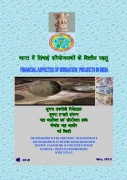/topics/rivers
Rivers
Study of ancient water storage systems on forts in Nashik district of Maharashtra - Paper presented at the National Seminar on Water and Culture (2007)
Posted on 14 Feb, 2011 05:11 AMThis paper studies the water supply, distribution, collection and storage in the forts around Nashik with the idea of testing the viability of implementing such systems in areas of similar topography. The history of forts in Maharashtra and the forts around Nashik and the water collection and distribution systems thereof are described.
Two ancient irrigation systems of India - Paper presented at the National Seminar on Water and Culture (2007)
Posted on 14 Feb, 2011 05:03 AMThe Phad system of irrigation, is found in Maharashtra over the rivers Panzara, Girna and Burai, which are tributaries of Tapi.
Water and culture vis-à-vis river diversions - Paper presented at the National Seminar on Water and Culture (2007)
Posted on 14 Feb, 2011 04:48 AMThis paper discusses river linking, as a part of an ancient tradition, and suggests how NGOs can play a role in this attempt. The example of the Koyna dam is taken, and the effective handling of the technical and human angle of the dams construction is detailed through in-depth study and detailed field visits.
Ideal historical river water use systems - Paper presented at the National Seminar on Water and Culture (2007)
Posted on 14 Feb, 2011 12:02 AMThe Phad system of irrigation which has been going on for centuries, is found in the northwestern parts of Maharashtra in the three river basins of Panjhra, Mosam, Kan and Aram. Weirs were constructed on these rivers to divert water for agriculture use. These weirs are locally called Bandhara. Each independent Phad system comprises of a diversion weir, a canal on the bank and distributor channels for irrigation.
Idol immersion activities and their management in water bodies in India - Paper presented at the National Seminar on Water and Culture (2007)
Posted on 13 Feb, 2011 11:07 PMThis paper begins with an analysis of the rationale for idol immersion in Hinduism. Some of the reasons given by the author include water being able to disintegrate idols, the idea of purity of water etc.
Irrigation in India - Management phases and its sustainability - Paper presented at the National Seminar on Water and Culture (2007)
Posted on 13 Feb, 2011 10:52 PMSince time immemorial water has been a common property and in many Indian communities there is deep reverence for flowing water. Using the flow of water for community benefit is considered an act of great merit and its misuse and contamination, a sin. In temples, tanks were constructed for rituals and also as a way to earn money for the temple.
Non-compliance of dam agencies in construction of hydro-electric projects in Himachal Pradesh - A photo-essay by SANDRP
Posted on 13 Feb, 2011 03:02 PM
Download the photo essay:
Financial aspects of irrigation projects in India – A report by the Central Water Commission
Posted on 13 Feb, 2011 08:28 AM This publication by the Central Water Commission presents data on Major and Medium Irrigation and Multipurpose projects, Minor Irrigation projects, Command Area Development scheme as available in the Finance A
This publication by the Central Water Commission presents data on Major and Medium Irrigation and Multipurpose projects, Minor Irrigation projects, Command Area Development scheme as available in the Finance A
Latest status of the storage of important reservoirs in the country - CWC - PIB Release
Posted on 05 Feb, 2011 12:17 PMOf these, as many as 36 reservoirs are having significant hydro-power benefits with installed capacities of more than 60MW each. The combined live storage in these 81 reservoirs at the beginning of monsoon, i.e. June 1, 2010 was 14% of their designed capacity and stood at 60% of designed capacity as on January 27, 2011. The present storage is 137% of last year’s storage and 145% of last 10 years average storage during the same period. Out of these 81 reservoirs there are presently 15 reservoirs where this year’s storage is less than 80 % of the average of previous 10 years and in remaining 66 reservoirs the storage is more than 80% of the average of previous 10 years.
Wetlands (Conservation and Management) Rules 2010 - Welcome, but a lost opportunity - Press release by SANDRP
Posted on 04 Feb, 2011 10:33 AMOn the occasion of the World Wetlands Day 2011, while we welcome the notification of Wetland (Conservation and Management) rules 2010 by the Union Ministry of Env





